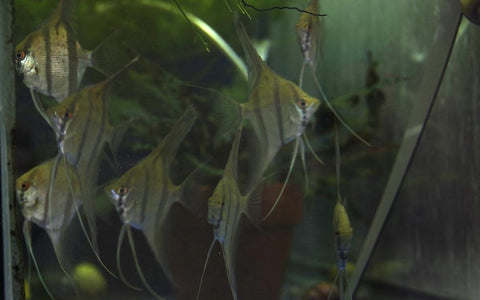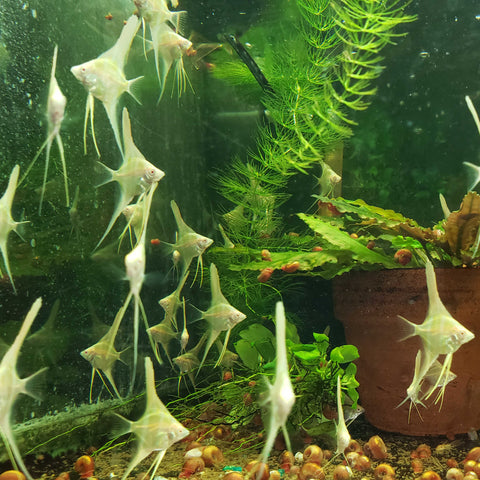
I first saw albino Dantum angelfish in person a few years back. I was in the fishroom of an IFGA breeder and observed the pair and some newly hatched fry from that pair. The pair was a very typical looking albino (though Dantum albinos have a slightly different look to them from the regular albinos in the hobby). The fry however, were different. They weren’t clear with the normal pink, almost transparent eyes. They had a greyish hue to them, both in the eyes and the body. This was my first clue that this variety was different. Since then, it has been demonstrated by a couple of breeders that when you cross an albino Dantum to a traditional albino, none of the offspring are albino – the gene causing the albino Dantum was on a different location!. Cool discovery and one that is fairly common in other fish species. There appear to be several genes that can control or inhibit the production of melanin. I’ve personally witnessed this in guppies and Ancistrus.
Fast forward a few years – I finally caved to the urge to bring in some albino Dantums. I’m always reluctant to bring in new fish because my quarantine procedures are so stringent, it takes me about 6 months before I’m confident that the fish are clean (I trust no source or any other breeder). I won’t go into the detail of my quarantine process, but I will say it’s stressful on the fish and they go through conditions that almost no other fish is likely to be put through by the average hobbyist. I ordered these from a breeder who I respect for the quality of his fish and the obvious attention to detail he gives them. They arrived in good condition, about quarter size bodies, and had no apparent problems. They had that slightly different look of the Dantum fry I had previously seen. Albino, but a light greyish hue to the body and eyes. They went into the quarantine tank and were subjected to my stressful treatment regime. The quarantine tank was unlit for 16 hours/day and then for 8 hours was lit by a very low-intensity bulb, maybe 2 watts/gallon.
About a month went by before I really noticed anything. With the dark tank and the quarantine procedure, I didn’t pay much attention to them. Then it occurred to me, they don’t look right. They were too dark, too much like a wild-type silver angelfish. After a couple more weeks, they looked even less like an albino. That is when I took the photo in the caption of this article. I contacted the seller and he assured me they were albino and that out of the hundreds he raised, all looked albino. I fully believed him and trusted that he knew what he was doing. I then started to think that something in the environment I provided had caused the melanin production to continue as in normal angelfish. After a little online research I discovered that in albino animals, if a trigger caused the enzyme tyrosinase to be turned on, then this fish with two albino genes would have those genes not activated. So, there are environmental triggers that prevent the expression of albino, or if you want to look at it a different way, that allow the production of melanin even in the presence of homozygous albino.
I first posted about this on an angelfish group on Facebook. Most responded that I must be mistaken and that the breeder sent me non-albinos. I couldn’t convince them otherwise. So, I decided to put this fish into a normal aquarium situation with normal lighting and increased hours of light each day. After two months, they had morphed about halfway back to the albino-look, seen in this video:
At this point, I knew I was on to something, so I kept them in the same tank, under the same conditions. After an additional 2 months, they looked completely albino as seen in this video:
I am now personally convinced that this evidence is enough to say that the gene causing albino in Dantum angelfish can be inhibited by environment – causing albino angelfish to revert back to normal coloration.
Here is one of the pairs with a spawn.
I put a couple pairs back into very dark tanks to see if the darker pigment would come back. Lo and behold, it did! This gene is very much influenced by environment from what I’ve experienced. The video below shows what a couple months in a dark tank did for the color.
The juveniles in the below photo are offspring from the original fish in this article. This clearly demonstrates that I did receive albino Dantums and that their expression of dark pigments is quite malleable.

